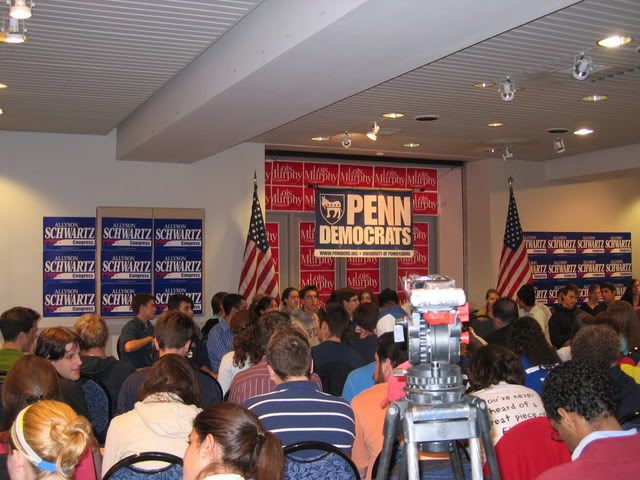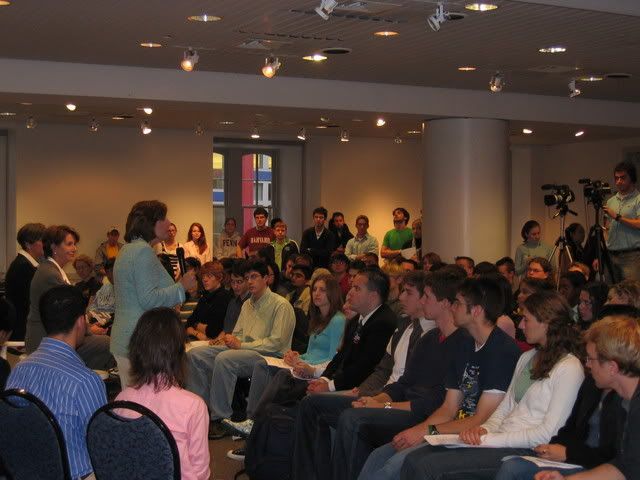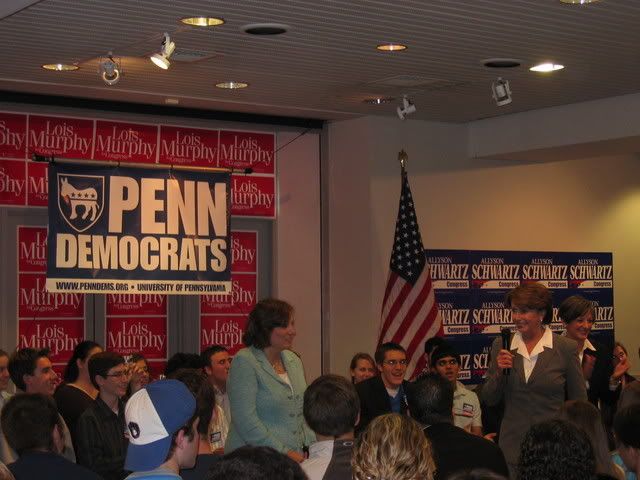(cross-posted at Deny My Freedom and Daily Kos)

Today, on Penn’s campus, a rally was hosted with House Minority Leader Nancy Pelosi (D-CA), PA-06 Democratic candidate Lois Murphy, and the incumbent from PA-13, freshman Rep. Allyson Schwartz (D-PA). Members from the campaign of PA-08 Democratic candidate Patrick Murphy were also on hand, distributing flyers for Wednesday’s upcoming rally with former president Bill Clinton. This is the big event on campus for the Penn College Democrats, and our board did a great job of setting up the event. We had a more modernized banner, and we were able to fill the room to standing-only capacity. For 10 AM on a rainy Friday morning, it was impressive to get that kind of turnout to see the next Speaker of the House.
That being said, if there is one thing this rally demonstrated, it is that it’s not very difficult to understand why we have such a difficult time convincing people to vote for Democrats. This rally – although well-organized by the Penn Dems – was the epitome of everything that is wrong with the Democratic Party’s messaging. Follow me below the fold for a full review…
At the rally, these booklets – exactly 25 pages long – were on every seat in the room; I snagged an extra one from the boxes. If you read the content, you will find that it is filled with reasonable ideas about veteran’s rights (above, on the left), energy independence (on the right), and many other issues. The claim that the Democratic Party is without ideas is completely false; and although the online version of A New Direction is much less fleshed-out, as I have previously criticized it for being, the actual booklet has a bunch of good proposals to help out all Americans, not just the well-off. Certainly, these are good ideas that we are running on, but most people don’t have the time to read these booklets. In fact, I have no idea if these are actually being distributed to voters; giving them to the choir isn’t going to accomplish much of anything – we need to convince those that aren’t ready to vote for Democrats.

Lois Murphy lost the closest race in 2004, losing to Jim Gerlach in PA-06 by a couple of percentage points in what was a strong Republican year around the country. She’s ahead in the latest round of independent polling, and many people in the area believe she’ll have no problem knocking Gerlach off this time around. Her speech largely focused on domestic issues, particularly global warming and energy independence. That being said, many of the issues that were touched upon were repeated by Schwartz and Pelosi later on. The one heartening thing Murphy said before the rally ended was that taking back the House was important so that ‘hearings could be held to hold the Bush administration accountable’. Investigations are something that leading Democrats have been shying away from calling for, so it’s good to see that a prospective congresswoman is seeing that such actions will need to be taken if we recapture the lower chamber of Congress.

Allyson Schwartz replaced Joe Hoeffel in PA-13, a swing district that has been trending more Democratic over the years, in 2004. Used by my political science textbook a couple years ago as an example of the prototypical ‘purple’ district, it’s not even on anyone’s radar anymore; when Hoeffel held the seat, his re-election races were never won with dominating margins. That being said, Schwartz touched upon the same domestic issues that Murphy had previously spoken about. To be honest, there was nothing of much note said; in fact, the applause that occurred during her part of the event was sparse and probably numbered less than 5 in interruptions.

Schwartz introduced Pelosi to us, who got a rousing ovation from everyone except for the Penn College Republicans, who decided to stand at the back of the room and watch – probably because they never hold any events to begin with, and the ones they do host aren’t worth the waste of time. After saying a few quick applause lines to get the crowd riled up, Pelosi went about speaking to us about ‘A New Direction’. She touched on just about every major topic in today’s news, with the notable exception of the Mark Foley scandal. I planned to ask her a question about it afterwards, but I wasn’t called upon. Another somewhat surprising observation was that Iraq was not mentioned at all until the very end of her speech – in fact, I’d call it an afterthought, and it was abruptly tacked on just as Pelosi had appeared to wind down her remarks. The first question that was taken from the students was one about whether the Democrats would agree to a one-year timetable, similar to what Rep. John Murtha (D-PA) and Sen. John Kerry (D-MA) have proposed. Pelosi never answered the question directly, saying that most people supported Murtha’s position, citing the unified position that congressional Democratic leaders have taken by calling for a withdrawal plan to be implemented by the end of 2006. Aside from that, your typical bread-and-butter issues were once again spoken about. Noticeably absent from the rally was any discussion about social issues such as abortion and gay rights, which I think is a good sign. When the GOP is on the offensive, it usually seems to force us to defend our stances on the issues. With the Foley scandal and the general collapse of the GOP, there’s no chance for them to use red-meat social issues to fire up their base.
Overall, it sounds like a pretty decent rally, right? A short 45 minutes long, it touched on all the issues we want to hear Democrats talk about, and it brought out probably 200-250 college students and may have inspired them to contribute some time to volunteering (a point that Murphy, Schwartz, and Pelosi repeatedly made). On the contrary, it was highly disappointing, and I wish I had more to talk about with regards to the substance of the rally. Instead, I will critique the event to highlight the problems the Democratic Party exhibits when it campaigns.
Know your audience
To a casual non-observer of politics, it may not have seemed out of the ordinary. But to someone like me – a person who has attended several political rallies – it was painstakingly obvious that Murphy, Schwartz, and Pelosi were not speaking to the audience. At least Schwartz was able to crack a couple of jokes about waking up for the rally and for trading our sleep for volunteering, but aside from that, and everyone spoke about college loans. Past that, though, there was no indication that there had been any adaptation from the traditional stump speech to make it more appealing to a group of young voters. Most people in the audience are not people who have attended political rallies on a regular basis before, so one cannot expect them to know where the applause lines are – they’ll applaud for something they like to hear. There were plenty of lines that would normally draw applause from a much more involved and aware group of people, but in this setting, they drew a stony silence. At certain points, one person essentially began clapping to goad the crowd along. You have to know who you are presenting to, and you have to be able to adapt as such. Patrick Murphy is excellent at doing that – although he includes elements of his stump speech every time he speaks, he is able to make it much more appealing to the audience he is targeting.
Know what issues matter
Being at an Ivy League school, speaking to us about issues like outsourcing manufacturing jobs, health care, and retirement shows a certain tone-deafness. Domestic issues dominated the discussion, but it wasn’t in a context that would appeal to students. Penn in particular is not a place where many people worry about getting a job out of college, given the excellent recruiting program that Wharton has in place, and almost everyone here will be in the upper-level service sector out of college, which does have an outsourcing problem but is less pronounced. I was waiting to hear about Iraq. That is an issue students care about. To their credit, they did mention college loans (although, at an Ivy League school, there are a minority such as myself that have to worry about that problem), but it wasn’t put in the proper context. Finally, civil liberties – as the recent revolt on the networking website Facebook showed, students care a lot about their privacy, no matter how trivial the matter. There was no mention of the Patriot Act, NSA wiretapping, or other personally intrusive behavior. Finally, judging from the outpouring of support on Facebook on the matter of Darfur, human rights issues are also another winner. But no mention of Darfur – or on torture, which probably was not an issue that Pelosi wanted to address. Stem cell research – another big winner with college students – was mentioned only once, by Pelosi, and it got a huge response. The minimum wage is certainly an important matter, but when you’re speaking to a roomful of people who will undoubtedly be working at jobs out of school that pay way above it, one has to wonder why it’s being mentioned. Talk about the issues that young people care about, and they will respond.
Slogans are not a cure-all
I must not have rolled my eyes too much, as they would be rolling on the floor for each time ‘A New Direction’ was mentioned. Just as the party got too attached to the ‘culture of corruption’ phrase when the Abramoff scandal was front and center, the Democrats have got to learn to become more varied in their language. At some point, I began to wonder, “Just what is ‘A New Direction’ all about?” People may not remember the details, but it certainly helps if you delve into the meat of your policy stances instead of throwing one slogan out and telling the audience to ‘Read the book’ (Pelosi literally told us to do that). In addition, this ties into knowing your audience. In an academic setting, students will be eager to hear about the details of the plans and just what that entails. Energy independence is great – but what does it mean? Investing in education is great – but what does it mean? Having a dignified retirement is great – but what does it mean? Abstract phrasing and sloganizing simply aids the perception that we don’t have any ideas. Talk about the details, and talk about them to whatever length is necessary. In general, though, there has to be an improvement in messaging. The audience isn’t stupid, and if they keep hearing the term ‘A New Direction’ over and over, they’ll want to know what exactly that entails.
Tell a story
Having a running theme in a campaign should be required. ‘A New Direction’ is not a theme or a story; it’s a slogan. When one listened to Murphy, Schwartz, and especially Pelosi speak, there was absolutely no running thread at all. We would go from talking about bread-and-butter issues to talking about Philadelphia and the country’s values to national security to global warming – and it goes on and on. There was absolutely no coherent way one could link what each woman was saying together; instead, it was a potpourri of various issues that were spoken about repeatedly without any additional illumination. Perhaps campaigning is supposed to be about saying a whole lot of nothing, but there was so much repetition – without added substance – that it made my head spin. We have to tell a story when we campaign; it can’t just be a laundry list of what we want to do if we retake Congress. This is a problem that seems to afflict all Democrats, and we need to move away from it. Barack Obama’s 2004 DNC speech is a perfect example of the kind of politicking we need to do more of. Make it personal, make it flow, make it matter – and you can captivate anyone. People may agree with us on just about every major issue of the day, but they’re most affected by the messenger. Admittedly, Nancy Pelosi is not the best public speaker, but it would be difficult to string together a more incoherent speech than what she did today.
Simply put, all of these issues fall under the umbrella of framing. One can get away without the best framing when preaching to the choir, but we’re not the ones who will tip the scales at the polls. It will be those voters who know they agree with us, but they are reluctant to do so because we’re not inspiring enough. Republican ineptitude may give us Congress now, but there won’t be a Mark Foley to do our work for us every election cycle. Hopefully, this can serve as a template to identify what we are doing right – but more importantly, what we need to fix.



Frightening how incompetent they are isn’t it? They still use the playbook from 1992.
So I was just reading a really gifted writer, Glenn Greenwald, talking about how perfectly Pelosi has handled the last few days. And then I see this ponderous and unreadable critique by a college student.
The last paragraph starts out: “Simply put, all of these issues fall under the umbrella of framing.” What the hell does that really mean? I think it’s just a bunch of pretentious jargon. I’ll bet Nancy Pelosi knew more about real politics 50 years ago, when she was a teenager, than this writer ever will know, or at least not for a very long time.
Good to hear some really constructive criticism there, as well as an unwarranted insult. Asshole.
giggles.
Knowing your audience is key. I’ve been to a couple political rallies and they put me to sleep.
Maybe the myth about college students not voting is because nobody competes for our vote…